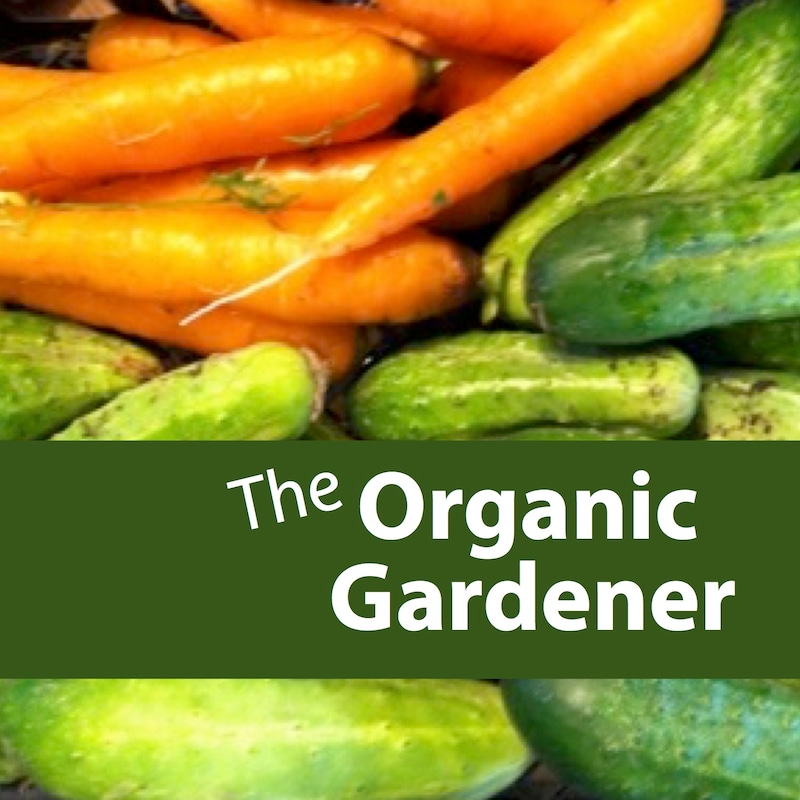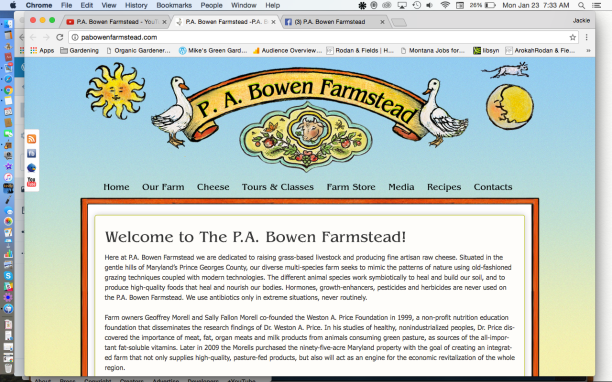
Shownotes
I’m super excited because I have a guest who is going to talk about cooking and nutritious food and I’m very excited because I’m trying to improve my healthy cooking and diet for 2017! Sally Fallon is here from Washington, DC on this cold morning.
Farm owners Geoffrey Morell and Sally Fallon Morell co-founded the Weston A. Price Foundation in 1999, a non-profit nutrition education foundation that disseminates the research findings of Dr. Weston A. Price.
Tell us a little about yourself.
I am, my expertise is not gardening, I am a writer and I wrote the book
Nourishing Traditions: The Cookbook that Challenges Politically Correct Nutrition and Diet Dictocrats
Nourishing Traditions.com and founded the Weston A. Price Foundation and we advocate for a return to nutrient dense foods and non-toxic foods! That’s where the organic gardening comes in.
I live on a farm. My husband and I bought this farm in 2009. We have been farming for the last 5 years.
We have a dairy herd
- We make raw cheese
We sell:
- raw pet milk
- pastured pork
- pastured eggs
- pastured chicken
- pastured turkey
We have a store on the farm where we sell local products. As far as vegetables are concerned we sell lots of lacto fermented foods:
- sauerkraut
- natural pickles
- beverage called beet kvass which is fermented beet juice
- natural ketchup
- crispy nuts
-
maple syrup
-
maple sugar
-
local honey
We do sell fermented vegetable foods.
This is so exciting because we just passed a cottage food bill in Montana encouraging people to have more businesses like that that sell these kind of products and Mike has wanted to sell pickles at the farmer’s market. (or even just pass them out to kids)
We do try to support local businesses, we have a gal who makes the sauerkraut for us and a gal who makes the beverage. We sell a natural ketchup and some crispy nuts which are nuts that have been soaked in salt water….
It’s interesting about the produce, last year for the first time in my life I had a greenhouse with vegetables in it, a hoop-house with vegetables. I have a lot of respect for people who grow vegetables… it’s not easy.
I can talk about some of the problems i had… of all the things done in farming vegetables take the most skill … I definitely did not know what I was doing!
I am the big vegetable eater, but my husband has the green thumb and he is the grower! Even what my husband has done, he has perservered thorough some tough times.
We started out, put some raised beds in with some railroad ties, put 5 beds in…
I have had some luck with
- strawberries
- rhubarb
- asparagus is doing well
more tender things I’ve had problems with, not the weather but my biggest challenge is groundhogs
They can eat a whole raised bed in one night! You come out the next day it’s gone!
One of the challenges I made was I want to grow french beans, the real tender beans… but the groundhog liked them even more then I did… so last year I bought some cute little cages that went over the beans, but the cages were too small and the beans were a little bit stunted, they grew into the cage and couldn’t grow any more but they kept the groundhogs today.
I had a guest on, Naomi Wheat who runs our Farmer’s Market here said:
“You know what I think is working the best I can’t even say this for sure, but I dug holes and put wine bottles all around the entire garden burying them every couple feet or so with the next sticking out and they said the wind blowing through it would create a sound that they didn’t like… it would scare them… They don’t like noises and smells. The wind blows over them… And dumping coffee grounds down the holes too!”
So she said she puts little umbrellas she makes out of a stick and a tin can over the top so the rain doesn’t get in. So they would stay dry and make more noise and the noise seems to scare the pests away.
HOOPHOUSE Ambitions!
Well, I invested in these cute looking french looking cages, they did work. I grew some lettuce with those cages fairly successfully. I did put a hoop house in a pretty big one … last spring I planted in the hoop house
ambitious
- spinach
- lettuce
- parsnips
- tomatoes
- eggplant
- peppers
- zucchini
- cucumbers
- beets
- potatoes
- chard
Some did really well. The chard did well, peppers did well. No tomatoes. Literally 0 tomatoes. The parsnips had these beautiful green leaves. I was so proud of them, let them get big… and I walked in one day and the leaves were eaten clean. There was a hole at the end of the greenhouse where the groundhog had gotten in, we ate them but they were kind of small.
zuccini leaves
did get
- potatoes
- beets
- peppers
- chard
Here was the real bad thing. I’d go in and weed every morning. I was gone 2 weeks to a family wedding in California. I have a funny picture of this greenhouse! It was unrecognizable, the grass the weeds grew so tall, in just 2 weeks.
Perfect growing conditions.
Here in Maryland there are a couple of months where things grow so fast it’s scary. My husband is from New Zealand and said he’s never seen growth like we get here in May and in June.
LESSONS LEARNED
I’ve learned a few lessons
One thing I did not do was fertilize at all. This year I’m gonna put some organic fertilizer on.
Tomatoes can be tough.
We put it on at the beginning … we didn’t do it at the end.
Recipes
2 ways of preparing vegetables
There’s salad vegetables you make a salad with and cooking vegetables you cook.
- always have that with some good butter we eat our vegetables swimming in butter
- always you put salt on your vegetables
You get a lot more from the vegetables when you cook them that way!
- Maybe you add butter
- eggplant fry in lard
- put cream on them.
YOU want some kind of fat with those vegetables!
The other thing is the lacto fermentation
- sauerkraut
- pickles
- fermented salsa
a whole range of things you can do
That you do with a culture starter, I use
- whey and salt
These are all in my book Nourishing Traditions: The Cookbook that Challenges Politically Correct Nutrition and Diet Dictocrats
Lacto Fermented Foods
It’s a great way to preserve your garden, you have those all winter long! The nutrients increase when you lacto ferment, the level of Vitamin C go up tenfold.
10 times more vitamin C
That seems to be the big thing today… lacto fermented foods.
That all started with my book Nourishing Traditions, I have the way it’s small scale, that’s fool proof and you don’t have things that go wrong when you do it according to my method
2nd basic way of preparing vegetables
end up with a big crop of tomatoes
- actually peel them,
- dip them in hot water
- cut them in half
- squeeze out the seeds
- chop them
- saute onions in butter or good fat
- chopped seeded peels
- cook at low temp for a long time, even all day
- put your wiz or soup blender and blend it
- and go ahead freeze it
makes a beautiful slightly carmelized sauce and it really make those tomatoes delicious!
freeze them…
always end up with lots of tomatoes, don’t know what to do with them, so I spend a day with them!
That’s a great answer, I used to have a questions for preserving and harvesting because that’s always one of my big challenges.
So things like beets
I ferment
beet pickeled beets
Beet Kvass
- take a jar, quart size jar
- chop up about 1 large beet,
- peel it,
- corsely chop it and put it in there,
- fill it with water,
- add a table spoon of good salt,
- 2 TBLSpoons of homemade whey (you make by starting culture, yogurt)
- leave on the counter,
- then it goes in the fridge
These will last for a year or longer…. it’s a very healthy medicinal drink
Potatoes and onions will keep a long time if you keep them cold. Things like zucchini, if you end up with tons of zucchini you don’t know what to do with.
I don’t have that problem as much with zucchini, because I like to eat them when they are really small, just the size of a quarter in diameter and so I put them on everything, but I pick them so frequently I don’t end up with tons and giant zucchinis, they keep producing. My challenge is more eggplants.
Eggplant Love
Now, we love eggplant. Here’s how I prepare eggplant
- peel
- slice them
- sprinkle salt on all the slices on both sides let them sit, black juice comes out
- wash them off and dry with paper towels
- then I fry them and make a platter of fried … they are so delicious that way
- sprinkle chopped garlic
I don’t peel them because I like the peels… and then actually wash em off and dry them.
I don’t can dip them in batter, breading, make a thicker slice, bread them…delicious!
And the other thing you’re making me think, I get so spoiled with Mike’s beets and things, I usually put beets on my salad instead of buying tomatoes in the winter, I didn’t realize I’m getting the benefits of fermented foods!
These are all in my book Nourishing Traditions: The Cookbook that Challenges Politically Correct Nutrition and Diet Dictocrats
When you do this the right way, the true lacto fermentation…
When you eat sauerkraut, or the pickled beets, you are getting a lot of digestive enzymes and beneficial bacteria for your own digestion
We really should be eating these fermented foods with every meal
If you grow your own…that’s like the BEST Of the BEST!
I thought just a tablespoon a day is good.
That’s what I meant with lunch or dinner.
Have you ever grown celery? I thought I would try that this year.
I haven’t been the most successful, but one...







